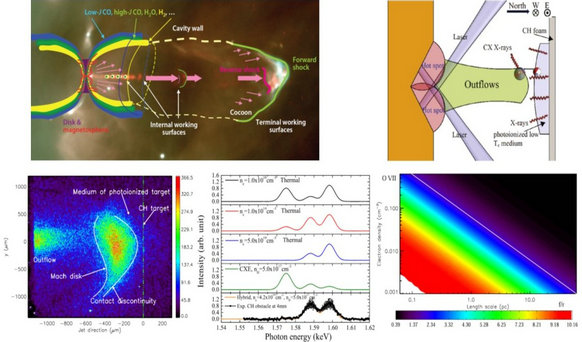Laboratory analog for collision of outflow with dense clouds in protostar or M82
Outflow or jets are important feature for star-formation region, and are main solution for researchers to explain many key issues in star-formation. Properties, such as morphologies, size, and velocities, of outflows provide fossil records of the mass ejection and, by inference, the mass accretion histories of forming young stars.
X-rays can trace the nearest origin of outflow, and to explore the mechanism of jet production and its collimation. The mechanism is still not clear, although various feedback models of interaction with interstellar medium have been suggested by numerical magneto-hydrodynamic simulation to explain the X-ray emissions.
A recent research study led by Profs. ZHAO Gang and LIANG Guiyun from the National Astronomical Observatories of the Chinese Academy of Science (NAOC), reports a laboratory analog for the phenomenon in Herbig-Haro 248 and starburst galaxy M82.
The results were published in The Astrophysical Journal this February.
By using powerful laser facility of Shengguang-II sited at Shanghai, supersonic outflow with velocity of 330 km/s was generated, that is comparable to that in protostellar outflow. This provides an excellent opportunity to investigate the outflow feedback in star-formation region.
For both the large-scale astrophysical plasma and the small-scale laboratory plasma, the fundamental physical principles are same for them. By using scaling law in time, spatial and density, both of them are similar in many aspects. "We can reproduce and investigate the astrophysical phenomenon, as in HH 248 or M82, in laboratory, and further reveal the fundamental physics in astrophysics," said Prof. LIANF Guiyun, the first author of the paper.
"By such experiment, a different conclusion has been found that the X-rays in HH 248 are mainly from the outflow material heated by reverse shock, namely Mach disk. It differs from past understanding thatthe X-rays are from interstellar medium heated by shock," said Prof. LIANG
By a sophistical emission model, they deduce that charge exchange takes place in such a laboratory miniature, as in the cases of HH 248 and Cap in M82.
However, there are still some differences after scaling law for the two different systems. A further laboratory exploration is necessary to figure the pictures of outflow interaction in protostars.

Figure: A cartoon of a protostellar outflow lobe (Credit by Bally, 2016), and Laboratory miniature for the outflow interaction with cold medium along with measurement results (Credit Liang et al. 2022).
This paper is available at https://iopscience.iop.org/article/10.3847/1538-4357/ac3de8